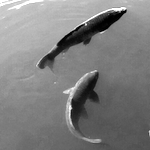Flapping insect wings are complex, heterogeneous structures that bend and twist passively under aerodynamic and inertial loads. In cases where the wing's surface density is high, deformation is dominated by inertial forces rather than fluid forces. Within this regime, wing deformation is more sensitive to structural features than fluid-structure coupling. Recent experimental studies indicate some deformation modes in insect wings exhibit non-stationary phase relationships, which may arise from non-uniform damping properties. We hypothesized that non-uniform damping generates traveling wave dynamics in flexible, flapping wings. We further hypothesized that traveling waves in deformable wings lead to increased propulsive efficiency relative to deformable wings experiencing standing waves.
To test these hypotheses, we developed a bilaterally coupled fluid-structure interaction model of a two-dimensional flexible plate heaving in a quiescent fluid. The fluid model was based on the unsteady vortex lattice method and the structural model was based on the finite element method. We considered both proportional and non-proportional viscous damping. Within the proportionally damped structures, wing deformation was governed by normal modes; the phase relationship between points on the wing was fixed. Within the non-proportionally damped structures, localized damping caused a phase lag between the wing mid-point and trailing edge, suggesting a traveling wave propagating from leading edge to trailing edge. When matching for peak deformation, the non-proportionally damped wing increased mean thrust by up to 20% compared to the proportionally damped wing. This suggests that traveling waves improve propulsive efficiency, which is consistent with other experimental studies in actuated flexible foils. This study highlights the potential importance of structural heterogeneity in insect wings and provides a design avenue for roboticists drawing inspiration from locomoting animals.

 PDF version
PDF version
